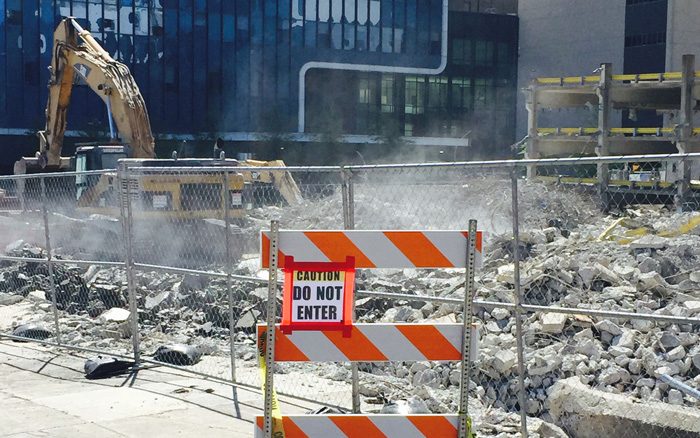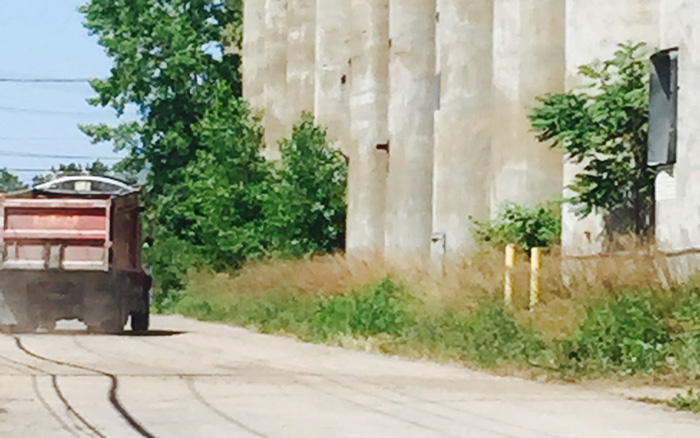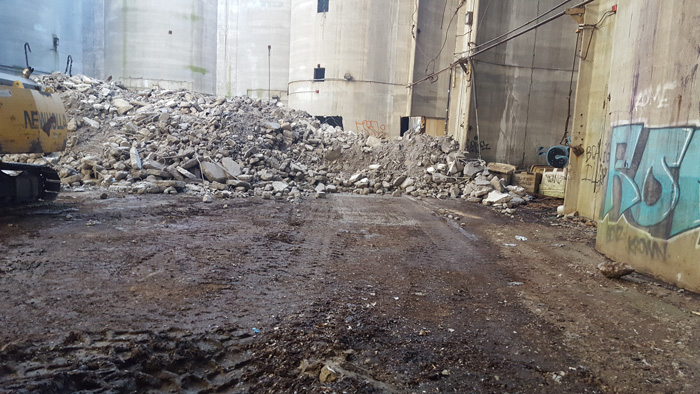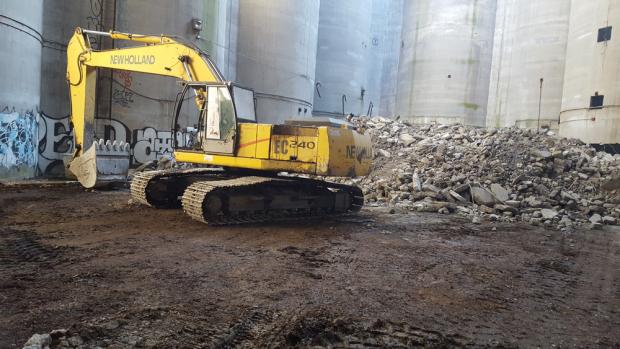The Public Record: Wasted Effort
On Friday morning, June 3, a cadre of red dump trucks began plying a circuit between a demolition site at North and Ellicott streets and the former Gelmac grain silos on the Buffalo River, at the corner of Ohio and Childs streets.
There once stood a city-owned parking ramp at the demolition site, now a rubble-filled hole in the ground, soon to be replaced by a bigger parking ramp operated by the Buffalo Niagara Medical Campus.

The trucks were filled with debris from the demolition of the parking ramp. (But not too full: If you were driving behind one—following it, say, from North Street to Gelmac—you wouldn’t see what was inside.) The trucks were dumping the debris inside the enormous Gelmac silos—once again, out of sight—where it was pushed around by a an excavator. The trucks arrived at a steady clip, maybe one every 10 minutes, for much of the day, taking a long break at lunchtime. The trucks drove through an enormous opening in the middle of the silos that is never secured: There is no door to close.
It’s an unusual place—and, it turns out, a totally illegal place—to dump such waste. So what gives?
Let’s add some color between the lines and see if a picture materializes.

The day before the trucks began dumping their loads at Gelmac, the state attorney general’s office shut down Peter Battaglia, Jr.’s concrete waste processing plant on Peabody Street, in the city’s Seneca-Babcock neighborhood. The shutdown was a long time coming, the result of neighborhood activism coupled with academic research into the air quality impacts of the yard’s concrete grinders, abetted by some political muscle and amplified by press coverage of the decade-long conflict between the intransigent Battaglia and the community in which his plant operates. Finally, last week, New York State Attorney General Eric Schneiderman piled on, filing a lawsuit accusing Battaglia of violating state environmental laws and operating without required permits. Schneiderman ordered the plant to cease operations.
(If you’re not familiar with the plant or the ongoing effort to force Battaglia to comply with state law, take a ride on the I-190 northbound; on your right, between the Seneca and Smith street exits, you’ll see a piece of concrete with a graffiti artist’s blue tag atop a pile of rubble as tall as the highway. That’s the place. We’ll post some links to relevant stories online, too.)
Battaglia is a brash, burly, Harley Davidson-riding guy whose presence reads like a flipped-up middle finger. He is some kind of kin to developer Carl Paladino—bragged about the relationship during an interview several years ago—so perhaps he comes by his attitude honestly.

Paladino is the owner, with a couple partners, of the Gelmac silos; they bought the structure in 2007. Paladino has expressed no plans for the site; he has just been sitting on them, while the adjacent Silo City complex continues to gain traction as a center for arts and cultural activities.
The demolition contractor for the parking ramp on North Street is Mark Cerrone, Inc., a contractor based in Niagara Falls. That demolition was supposed to have begun a month or so ago, but rarely do things like that happen on time.
Can you do the paint-by-numbers? Here’s the picture I’m drawing:
Cerrone won the bid for the demolition contract from the City of Buffalo. The company is obligated under the contract to dispose of the attendant waste at a suitably licensed facility. My guess is that they contracted with Battaglia to take the waste.
But then Battaglia was shut down by state authorities. Cerrone could not let that hiccup prevent the company from continuing its work; Battaglia did not want to forfeit his contract and the money that comes with it, but his gates are locked.
So perhaps his relative, Paladino, found a way to keep Cerrone on his timetable and preserve the contract for Battaglia. Again, just a guess.
Unfortunately, and however it came about, it was an illegal and potentially dangerous solution. Gelmac’s roof is none too stable—not the kind of place where you want to be working with heavy machinery that produces wall-shaking vibrations. And, as noted above, the site is not permitted for such waste disposal. We have this from Jim Comerford, the city’s commissioner for permits and inspections. Contacted late Friday afternoon, Comerford said he’d look into it first thing Monday morning. Monday morning, he said he’d sent an inspector to tell Cerrone “to inform him that he must remove the construction debris and cease from dumping any further material.”
Further, Comerford said, Cerrone have to remove all the waste already disposed there, pending receipt of a temporary transfer station license.
As of our Tuesday print deadline, the excavator that had been arranging the waste within the cavernous Gelmac silos had been removed. But the demolition debris was still there.

